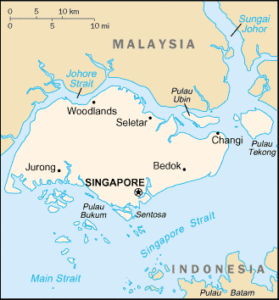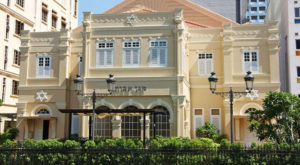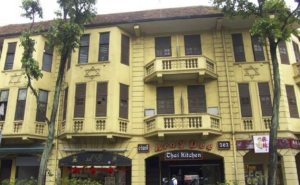 Singapore’s first wave of Jewish immigrants arrived from the Baghdad during the 18th and 19th century, due to persecution. In 1819, the Sultan of Johore permitted Sir Stamford Raffles and the East Indian Company to establish a trading post in Singapore.
Singapore’s first wave of Jewish immigrants arrived from the Baghdad during the 18th and 19th century, due to persecution. In 1819, the Sultan of Johore permitted Sir Stamford Raffles and the East Indian Company to establish a trading post in Singapore.
The British East India Company was expanding and Jewish people followed them to Singapore. The first synagogue for the Jewish community was set up in a small shop house at Boat Quay in 1841.
In the 1870s a new synagogue, Maghain Aboth, was set up to cope with the increasing population.
 By the early 1900s, the Jewish population had doubled, so Manasseh Meyer, a rich Jewish merchant, built Chesed-El on his private residence. While the community remained largely Sephardi, Ashkenazi immigrants from England, the Netherlands, China, Russia, and Germany settled there. On the eve of World War II, there were 5,000 Jews in Singapore. Many of these were interned during the Japanese occupation. After liberation, many Jews emigrated to Australia, England, the United States, and Israel.
By the early 1900s, the Jewish population had doubled, so Manasseh Meyer, a rich Jewish merchant, built Chesed-El on his private residence. While the community remained largely Sephardi, Ashkenazi immigrants from England, the Netherlands, China, Russia, and Germany settled there. On the eve of World War II, there were 5,000 Jews in Singapore. Many of these were interned during the Japanese occupation. After liberation, many Jews emigrated to Australia, England, the United States, and Israel.
 In 1968 trade relations were established between Singapore and Israel. In 2004, it was revealed that the Singaporean army, which is considered one of the strongest in southeast Asia, was initially set up by Israel. The Israeli delegation divided into two teams. One, set up the defense and internal security ministries, while the other, established the military infrastructure. They followed the model of the IDF, with a standing army and reserves. The officers also served as instructors in the Singapore army’s first basic training courses and its first course for officers, both commissioned and noncommissioned.
In 1968 trade relations were established between Singapore and Israel. In 2004, it was revealed that the Singaporean army, which is considered one of the strongest in southeast Asia, was initially set up by Israel. The Israeli delegation divided into two teams. One, set up the defense and internal security ministries, while the other, established the military infrastructure. They followed the model of the IDF, with a standing army and reserves. The officers also served as instructors in the Singapore army’s first basic training courses and its first course for officers, both commissioned and noncommissioned.
As of 2015, there are 2,500 Jews in Singapore, many of whom are recent Ashkenazi migrants.